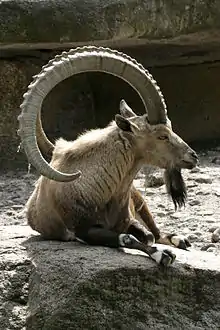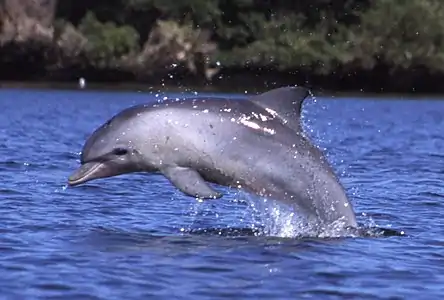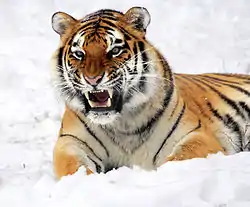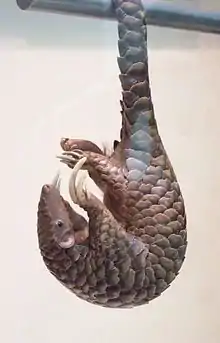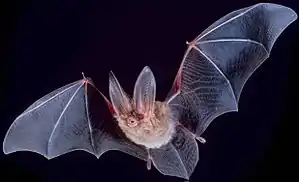Scrotifera
Scrotifera is a clade of placental mammals that comprises the following orders and their common ancestors: Chiroptera, Carnivora, Pholidota, Perissodactyla and Cetartiodactyla, with the latter including the traditional orders Artiodactyla and Cetacea. Scrotifera is the sister group to the Eulipotyphla and together they make up the Laurasiatheria. The last common ancestor of Scrotifera is supposed to have diversified ca. 73.1[1] to 85.5[2] million years ago.
| Scrotiferans | |
|---|---|
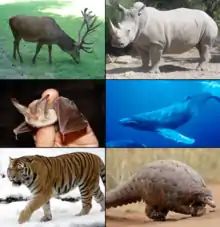 | |
| Major scrotiferan taxa: even-toed and odd-toed ungulates, bats, cetaceans, carnivores, and pholidotes (left to right, top to bottom). | |
| Scientific classification | |
| Kingdom: | Animalia |
| Phylum: | Chordata |
| Class: | Mammalia |
| Clade: | Laurasiatheria |
| Clade: | Scrotifera Waddell et al., 1999[3] |
| Subgroups | |
| |
Etymology
Peter Waddell, then of the Institute of Statistical Mathematics, explains the etymology of the clade's name as follows:
The name comes from the word scrotum a pouch in which the testes permanently reside in the adult male. All members of the group have a postpenile scrotum, often prominently displayed, except for some aquatic forms and pangolin (which has the testes just below the skin). It appears to be an ancestral character for this group, yet other orders generally lack this as an ancestral feature, with the probable exception of Primates.[3]
Phylogeny
The clade Scrotifera is based on evidence from molecular phylogenetics.[3][4] The monophyly of the group is well supported, although recent studies have indicated that the Pegasoferae is not a natural grouping.[5][6]
| Order-level cladogram of the Scrotifera in the context of the Boreoeutheria phylogeny (only living groups) | |||||||||||||||||||||||||||||||||||||||
| |||||||||||||||||||||||||||||||||||||||
| The cladogram has been reconstructed from mitochondrial and nuclear DNA and protein characters. |
See also
References
- dos Reis, Mario; Inoue, Jun; Hasegawa, Masami; Asher, Robert J.; Donoghue, Philip C. J.; Yang, Ziheng (7 September 2012). "Phylogenomic datasets provide both precision and accuracy in estimating the timescale of placental mammal phylogeny". Proceedings of the Royal Society B: Biological Sciences. 279 (1742): 3491–3500. doi:10.1098/rspb.2012.0683. ISSN 0962-8452. PMC 3396900. PMID 22628470.
- Zhou, Xuming; Xu, Shixia; Xu, Junxiao; Chen, Bingyao; Zhou, Kaiya; Yang, Guang (1 January 2012). "Phylogenomic Analysis Resolves the Interordinal Relationships and Rapid Diversification of the Laurasiatherian Mammals". Systematic Biology. 61 (1): 150–64. doi:10.1093/sysbio/syr089. ISSN 1063-5157. PMC 3243735. PMID 21900649.
- Waddell, Peter J.; Cao, Ying; Hauf, Jöerg; Hasegawa, Masami (1 March 1999). Olmstead, R. (ed.). "Using Novel Phylogenetic Methods to Evaluate Mammalian mtDNA, Including Amino Acid-Invariant Sites-LogDet plus Site Stripping, to Detect Internal Conflicts in the Data, with Special Reference to the Positions of Hedgehog, Armadillo, and Elephant". Systematic Biology. 48 (1): 31–53. doi:10.1080/106351599260427. ISSN 1076-836X. PMID 12078643.
- Zhou, X.; et al. (2011). "Phylogenomic analysis resolves the interordinal relationships and rapid diversification of the Laurasiatherian mammals". Systematic Biology. 61 (1): 150–64. doi:10.1093/sysbio/syr089. PMC 3243735. PMID 21900649. (Advance Access; published online 7 September 2011) "Our reconstructions resolve the interordinal relationships within Laurasiatheria and corroborate the clades Scrotifera, Fereungulata, and Cetartiodactyla."
- Zhou, Xuming; Xu, Shixia; Xu, Junxiao; Chen, Bingyao; Zhou, Kaiya; Yang, Guang (2011). "Phylogenomic Analysis Resolves the Interordinal Relationships and Rapid Diversification of the Laurasiatherian Mammals". Systematic Biology. 61 (1): 150–164. doi:10.1093/sysbio/syr089. PMC 3243735. PMID 21900649.
- Tsagkogeorga, G; Parker, J; Stupka, E; Cotton, JA; Rossiter, SJ (2013). "Phylogenomic analyses elucidate the evolutionary relationships of bats (Chiroptera)". Current Biology. 23 (22): 2262–2267. doi:10.1016/j.cub.2013.09.014. PMID 24184098.
